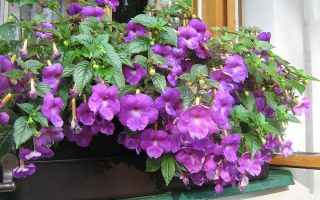Content
- 1 What does geranium look like
- 2 Geranium chemical composition
- 3 What diseases does geranium help against?
- 4 Geranium-based traditional medicine recipes
- 5 Geranium oil: properties and uses
- 6 How to make butter at home
- 7 The use of geranium in home cosmetology
- 8 Why geranium is useful in the house
- 9 Is it possible to keep geraniums in the bedroom
- 10 Signs and superstitions about geranium
- 11 Conclusion
- 12 Reviews
Geranium traditionally decorates the windowsills of houses and fills them with joy and comfort. It has medicinal properties and even magical qualities. When growing, the benefits and harms of geraniums are not taken into account by every owner, although earlier the flower was called a home doctor.
What does geranium look like
The botanical name for geranium is homemade pelargonium. It grows as a small shrub with erect stems that can be flowing down. The foliage is round or indented, covered with fine villi. The color is green, there are also varieties with variegated foliage. The flowers are smooth or velvety, collected in inflorescences. It blooms more often in red, but there are white, pink and other colors. The plant has a specific rich aroma. There are 250 varieties of it: some of them can be planted in open ground or in a hanging planter.
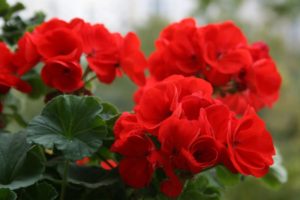
Geranium chemical composition
The use of geranium depends on a set of chemical elements that provide the flower with healing properties.
The plant contains in its composition:
- tanning agents;
- useful acids;
- ethers;
- flavonoids;
- pectin;
- carotene;
- ascorbic acid;
- glucose;
- fructose;
- alkaloids;
- vitamins;
- minerals.
Thanks to such a wealth of useful elements, geranium helps to heal many diseases. The plant's ether has a calming effect. Helps cope with stress. Young foliage relieves inflammation, normalizes digestion. Useful decoctions of the flower remove salts, stop bleeding.
What diseases does geranium help against?
The use of geranium as a source of medicinal elements and beneficial properties is irreplaceable for humans. These include:
- normalization of blood pressure;
- improved blood circulation;
- normalizing the work of the heart and muscular system;
- relieving headaches and toothaches;
- improving the functions of the gastrointestinal tract;
- properties to heal otitis media, osteochondrosis, sciatica;
- remove stones from the kidneys.
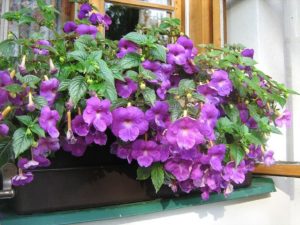
The beneficial properties of pelargonium also help to cope with colds and viral diseases. A runny nose is treated with juice from the leaves, an infusion is a sore throat. Despite the fact that pelargonium has a lot of healing properties, it also has some contraindications. In order not to harm the body, the intake of funds based on it is limited for such problems:
- asthma;
- individual intolerance and allergic reactions;
- diseases of the digestive system of a chronic nature;
- thrombosis: geranium juice tends to thicken the blood;
- pregnant and lactating mothers.
Geranium-based traditional medicine recipes
Considering the benefits and harms of geranium, medicinal infusions and decoctions for health are actively prepared from it according to folk recipes. Pelargonium is used externally and internally.It has antimicrobial, anti-inflammatory properties and is a powerful antidepressant that has a positive effect on physical fitness and mental performance.
It is worth paying attention to the benefits of geranium tea. The drink removes anxiety, improves mood, stimulates the brain without harm to the body.
The geranium is also great for women. Its properties to normalize the hormonal background relieve pain during menstruation and menopause. It is useful to use the plant not only for harvesting raw materials with healing properties, but also just to keep it in an apartment or house. Healers assure that geranium growing indoors also has properties to prevent the appearance of malignant neoplasms.
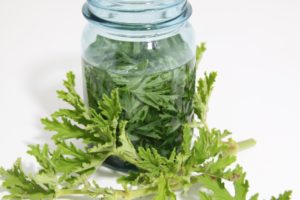
For insomnia and epilepsy
Thanks to the beneficial phytoncides contained in geranium, its aroma helps to cope with insomnia. For sleep disorders, the plant must be placed in the bedroom and kept there until sleep is normalized.
For insomnia, you can prepare a sedative, the beneficial properties of which will help in case of epileptic seizures.
For this you need:
- Pour the crushed root of the plant into cooled boiled water - 1 tbsp. l.
- Boil for 10 minutes.
- Insist for 1 hour.
Take a useful infusion of 2 tbsp. l. throughout the day, no more than 10 times. Excessive consumption can cause harmful side effects.
Toothache
The benefits of geranium leaves are also used in recipes for toothache: it is recommended to chew a leaf of a plant, and then apply it to a sore gum or tooth for 20 minutes. Alternatively, the shredded sheet can be glued with an adhesive plaster to the cheek from the outside.
From otitis media
Thanks to the beneficial tannins and trace elements of the plant, otitis media can be treated with its young leaves. For this purpose, they are rinsed under running water and then inserted into the ear.
This method relieves inflammation and headaches.
You can make an infusion:
- 30 g of geranium foliage pour 250 ml of hot boiled water;
- Insist half an hour, drain.
Drink 0.5 cups at a time.
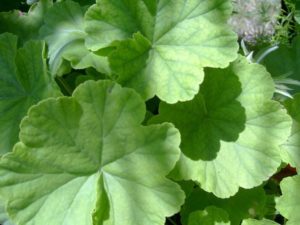
For constipation
The benefits of the pelargonium flower are manifested in the fact that an infusion can be prepared from it, which helps to get rid of constipation.
For this, 2 tsp. Pour the chopped herbs with 2 cups of cooled boiled water.
Insist for 8 hours. Drink a little during the day.
With increased pressure
The benefits and harms of indoor geranium for lowering blood pressure have been studied. To do this, you need to wrinkle and attach the sheet to the wrist, where the pulse is felt. Hold for 10 - 15 minutes. Useful potent elements will penetrate the skin and help reduce pressure. You can act differently. Just take a blank slate and chew on it.
For various skin diseases
Geraniums are used to treat cuts, wounds, burns, boils and other skin conditions. Grind the foliage until a gruel is formed. Apply the resulting raw material to the damaged area, wrap it with foil or parchment paper, insulate and secure. Do the bandage at night. With dermatitis and eczema, it is useful to treat the skin with an infusion of a flower.
From a cold
Useful properties of geranium, allow you to treat a cold. It is necessary to squeeze juice from the foliage and drip a couple of drops into the nose. This should be done 3 - 5 times a day, until cured.
With radiculitis and osteochondrosis
The health benefits of pelargonium are also used in cases of treating osteochondrosis and radiculitis. The greens should be kneaded until mushy. Apply to the affected area, cover with a soft cloth and film, insulate and secure. The procedure should be done at night, in the morning wash everything off.
For removing kidney stones
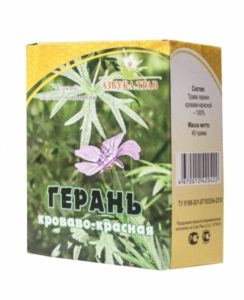
In the presence of kidney stones, it is necessary to prepare a useful geranium infusion.
How to prepare it:
- Pour 2 tsp into a glass of boiling water. dry crushed roots of pelargonium.
- Put on low heat and bring to a boil.
- Insist for an hour.
- Filter.
Drink 2 tbsp before meals. l. Take 5 times a day.The decoction is good because it does not push the stones out, but dissolves them. Therefore, they leave the body without harm and pain.
Geranium oil: properties and uses
The composition of geranium ether is rich in various useful elements. It contains alcohols and hydrocarbons. The phytoncides contained in it are of great benefit, killing microbes and viruses. Ether has a number of healing properties, because:
- serves as an antiseptic;
- relieves pain;
- relieves inflammation;
- has an antibacterial effect;
- quickly heals wounds;
- has antidiabetic properties;
- is a good insecticide.
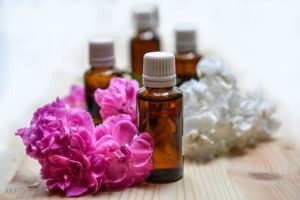
Geranium essential oil is an excellent diuretic, astringent, vasoconstrictor, deodorant, tonic, sedative. Due to the large number of useful properties and minimal harm, ether is used in folk medicine, cosmetology, aromatherapy. It is used for hand care, added to foot baths. The tool increases muscle tone, helps with cellulite: for these purposes it is used for therapeutic and prophylactic purposes.
How to make butter at home
Not all varieties are suitable for preparing geranium ether. Pink pelargonium works well. The ether from it is obtained with a greenish tint and smells like a rose.
You can cook it from flowers and leaves.
- Pour 2 tbsp into a glass of purified butter. l. crushed raw materials.
- Place in a dark place, leave for 5 days.
- After 45 days, keep on a windowsill, illuminated by the sun.
- Filter, pour into a dark jar or bottle and store on a shelf in the refrigerator.
The oil can be prepared in another way.
In this case, a small amount of ether (1 g) will require a lot of raw materials (500 sheets).
Cooking process:
- Pour some water into the container. For convenience, it is better to use a flask.
- Chop and add leaves.
- Close with a lid or stopper by inserting a glass tube through it into the container so that an angle forms.
- Lower the other end of the tube into a test tube, which is placed in a glass of cold water.
- Using a spirit lamp, heat the flask with geraniums.
- After a while, the foliage will begin to release ether: it will go through the tube together with the steam into the test tube.
- Due to condensation, the vapor will begin to turn into a liquid, on the surface of which a film will appear. This will be the geranium oil.
- Collect ether with a pipette or syringe.
The second way is much faster. But the amount of the resulting funds can be much less.

The use of geranium in home cosmetology
The beneficial properties of geranium are actively and harmlessly used in the cosmetic field. In the manufacture of some cosmetics, flower extract is used as an additive. At home, masks for the face and hair are prepared from geraniums, which:
- strengthens hair;
- rejuvenate the skin and nourish it with useful elements;
- improve complexion;
- reduce sebum production;
- eliminate acne, acne, flaking.
For the preparation of cosmetics, you can use both geranium raw materials and ether.
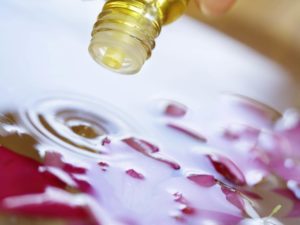
Geranium leaf mask for acne on the face
To prepare the mask, you will need geranium leaves and sour cream.
- Grind 2-3 leaves to a mushy state.
- Add 1 tbsp. l. sour cream and mix well.
- Apply the finished mask to the face.
- After 10 - 15 minutes, wash off with warm water.
Apply the mask no more than once a day.
Geranium for hair loss and dandruff
You can strengthen your hair without harm with the help of geranium infusion, for which you will need to chop the leaves.
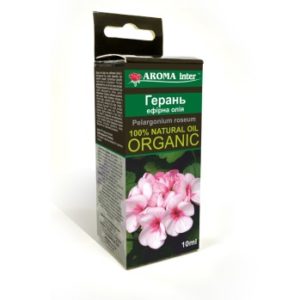
- 3 tbsp. l. Pour raw materials with two glasses of boiling water and cool.
- Infuse to wet hair along the entire length.
- Do not rinse.
You can prepare an anti-hair loss mask with geranium ether.
You will need 50 ml of base oil (olive, peach, etc.).
- Heat the base in a water bath.
- Add 5 drops of geranium and 3 drops of cedar ether, mix.
- Apply to hair for half an hour.
- Rinse thoroughly.
An anti-dandruff mask can be prepared as follows:
- Grind a large aloe leaf.
- Add 20 g of honey, 10 ml of lemon juice and 2 drops each of geranium, eucalyptus and fir oils.
- Mix all ingredients thoroughly.
Massage on the scalp and spread over the entire length of the hair. Keep for 40 - 45 minutes, rinse.
A hair strengthening and anti-dandruff mask prepared from geranium and nettle.
You will need:
- 3 tbsp. l. dry nettle leaves;
- 3 tbsp. l. dry geranium;
- 5 drops of any ether - to suppress the smell of grass.
- Pour dry raw materials with a glass of boiling water.
- Cover and cool.
- Filter through a gauze cloth.
Apply the mask to the hair, rubbing into the roots with massage movements. Leave for half an hour, then rinse with clean cool water.
Why geranium is useful in the house
It is recommended to grow the flower at home, even if it is not supposed to make infusions and decoctions from it. It will not only decorate the windowsill, but will also purify the air from bacteria and repel insects. In addition, the scent of the plant soothes the nerves, relieves headaches and has a positive effect on the entire body.
There is an opinion that the benefits of pelargonium for the home lies in its ability to divert envy, damage and slander from housing and family. She is also credited with the ability to prevent conflicts and quarrels.
But the cultivation of geraniums that are so beneficial can turn into harm when someone from the household is allergic to it: you need to be especially careful to plant the plant if there are children in the house. Pets should not be allowed to eat geranium foliage, this can also cause adverse reactions.
Is it possible to keep geraniums in the bedroom
Geranium has a calming effect, so it can be put in the bedroom. There it will help you fall asleep faster, and also make your sleep restful. But due to the strong smell, it is not recommended to place it near the bed, so as not to cause headaches or excessive sleepiness. It is better to place it on the sill of the illuminated window itself.
In a room, geranium can also be beneficial as an air purifier.
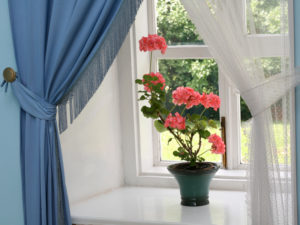
Signs and superstitions about geranium
Geraniums have been grown in homes for a long time. Someone uses it for decoration, someone - as a remedy, and someone endows pelargonium with magical properties.
Popular beliefs are associated with geraniums:
- If pink pelargonium flowers bloom in the house, in the near future someone living there will get engaged or fall in love.
- In feng shui, it is believed that blooming geraniums take all the bad energy out of the house.
- Pelargonium attracts love to the family.
- Geranium attracts prosperity and money, so it would be useful to carry a dried leaf or flower in your wallet.
- The plant with white flowers is credited with attracting customers, so putting it in the office would be a good idea.
- The flower protects against evil forces and negative energy: it protects from the evil eye, helps from conspiracies and love spells.
Believe it or not in the magical properties of geraniums is everyone's business. But the fact that the aroma of geranium invigorates and helps to cope with fatigue cannot be denied.
In any case, geranium will bring more benefits in an apartment, and only in rare cases can a flower cause harm in the form of a response from the body.
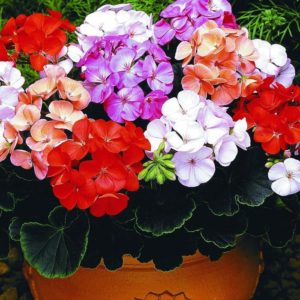
Conclusion
The benefits and harms of geranium have been known for a long time. And if you get to know the healing properties of the flower better, you may not need to run to the pharmacy at the first symptoms of a cold, headache, nervous strain or physical fatigue. The main thing is to check yourself and your household to ensure that useful geranium is not a harmful allergen.
Reviews

